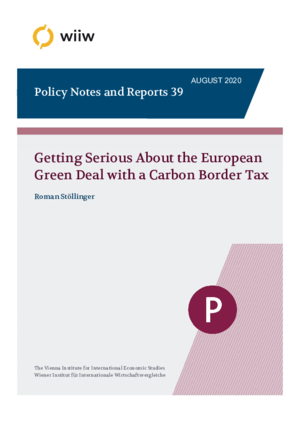Getting Serious About the European Green Deal with a Carbon Border Tax
wiiw Policy Note/Policy Report No. 39, August 2020
25 pages including 2 Figures
In December 2019 the incoming European Commission announced the European Green Deal (EGD), which aims to turn the EU into a climate-neutral, circular economy. Although it is as yet not very specific in many areas, the EU’s Green Deal sends the right signal and contains several promising elements. One of these is the introduction of a carbon border adjustment (CBA) mechanism mentioned as an option in the EGD. Apart from supporting the ecological objectives of the EGD, a carbon border tax can help to counter carbon leakage in EU industries that results from the EU’s internal carbon pricing system. This way, distortions of competition in energy-intensive industries due to asymmetric domestic carbon pricing policies can be partially remedied. Another positive side effect of a carbon border tax is that it would add a new source of income to the EU budget that is independent of Member States’ direct contributions. To reap this “triple dividend”, the CBA needs to be carefully designed both economically and legally. In particular, a European CBA mechanism needs to be compatible with the EU’s WTO obligations under the GATT. While this is challenging, it is perfectly feasible. Therefore the EU should introduce a carbon border tax as soon as possible, even though this is a high-risk strategy that is likely to increase existing tensions in the international trading system and will probably require an adjustment of its current trade policy.
Keywords: Carbon border tax, externalities, ecological transformation, WTO, EU budget
JEL classification: E01, O11, O40, O47
Countries covered: European Union
Research Areas: International Trade, Competitiveness and FDI
